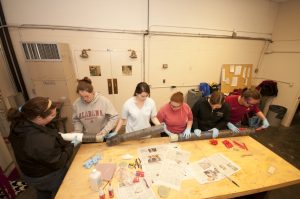
TUSCALOOSA, Ala. — Even those who are not rocket scientists know launching rockets is not easy. They are unpredictable and even slight miscalculations can result in failure.
After placing sixth in the 2012 NASA University Student Launch Initiative, the Rocket Girls, an all-female team of University of Alabama engineering students, are taking on the daunting task of creating a rocket for the third year in a row.
Once the team’s rocket is complete, they will launch it in Huntsville, April 20, where they will compete against 36 other college teams, including students from Vanderbilt University, Georgia Institute of Technology and Massachusetts Institute of Technology.
Team leader Shelby Cochran said they began preparing for the competition during summer 2012. After securing grants for the project, the team presented a proposal to NASA that included designs for full- and half-scale rockets for the competition.
Every year the team constructs a new rocket, each named after a famous female astronaut. For this year’s competition, they created “Dottie” after Dorothy Metcalf-Lindenburger, a NASA astronaut. Dottie was constructed by hand with carbon fiber and is 7-feet tall and 4-inches around.
What separates Dottie from previous rockets is the use of computer-designed grid fins, the same kind of fins used on NASA’s abort missiles. The grid fins are made of plastic and cut into small, diamond-shaped spaces. As the rocket shoots up, air flows in the opposite direction through the grids. Upon activation of the grid fins, the difference in air flow allows the team to slow the rocket’s speed, if necessary, and control its movement.
“[Designing a rocket] seems like one of those things that’s hard, but it’s basic physics so it really isn’t,” said team member Noelle Ridlehuber.
Before creating the full-scale rocket, the team members developed its half-sized counterpart, which they named ‘Thor.” Like Dottie, Thor’s outer-shell encases the motor used to power the rocket. To set off the rocket, the team only has to push a button on a remote control to connect to a wire inside the motor.
Judgment for the competition is based upon several factors. First the team is graded on its initial presentation and, later, the results of their half-scale launch. The team is also required to perform educational outreach by visiting schools throughout the state. Team member Kathryn Steele said young teenagers are typically at a critically indecisive stage in deciding their career aspirations and hopes that presenting them with the team’s rockets will show the fun side of engineering.
“A lot of them want to hold the rocket,” Steele said. “They ask if we can go outside and launch it. They’re usually most impressed with the parachute.”
Through their outreach efforts, the team hopes to encourage young girls to pursue science. “I’ve grown up on and off different engineering teams in middle school and high school, and I’ve always been only one of a few girls,” Ridlehuber said.
NASA will provide live coverage of the event on the social Web service UStream, complete with embedded Twitter feed. More on the event can be found by visiting the NASA Student Launch Project website.
The Rocket Girls are advised by Dr. J. Paul Hubner, associate professor of aerospace engineering and mechanics. Members of the team include:
- Haleigh Ball, a freshman majoring in mechanical engineering from Tuscaloosa
- Shelby Cochran, a junior majoring in aerospace engineering from Albertville
- Rachel Henderson, a freshman majoring in aerospace engineering from Ashland, Mass.
- Macy Gibbs, a junior majoring in aerospace engineering from Arab
- Desiree Kiss, a freshman majoring in aerospace engineering from Pass Christian, Miss.
- Anna Marthinsen, a freshman majoring in electrical and computer engineering from Northport
- Noelle Ridlehuber, a junior majoring in aerospace engineering from Simpsonville, S.C.
- Tiesha Salandy, a senior majoring in aerospace engineering from Huntsville
- Kathryn Steele, a senior majoring in psychology from Prattville
In 1837, The University of Alabama became one of the first five universities in the nation to offer engineering classes. Today, UA’s fully accredited College of Engineering has more than 3,900 students and more than 110 faculty. In the last eight years, students in the College have been named USA Today All-USA College Academic Team members, Goldwater, Hollings, Mithcell, Portz and Truman scholars.
Contact
Adam Jones, engineering public relations, 205/348-6444, acjones12@eng.ua.edu; Judah Martin, engineering student writer, jmmartin5@crimson.ua.edu
Source
Shelby Cochran, slcochran1@crimson.ua.edu